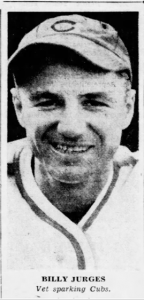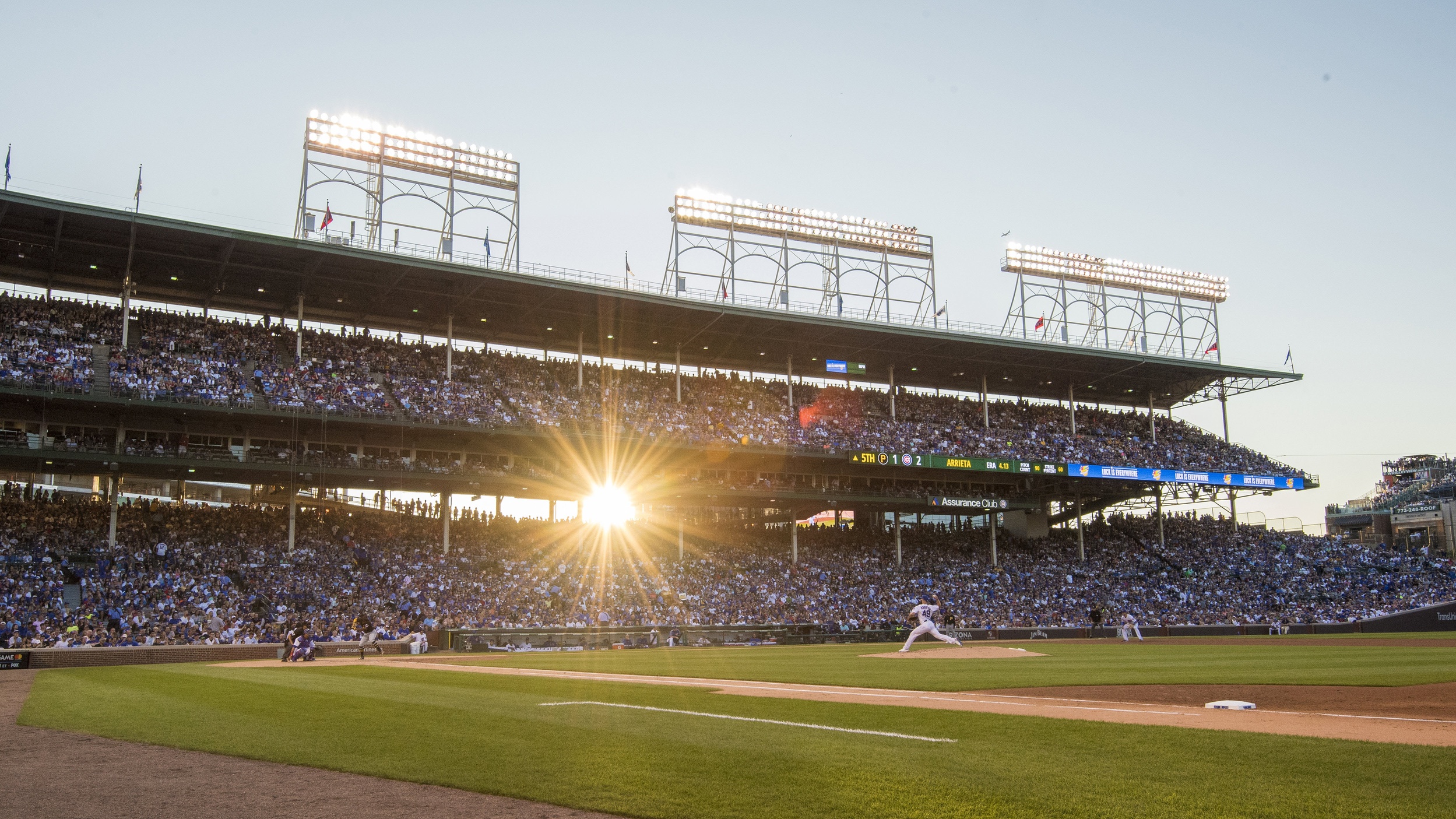Billy Jurges burst onto the baseball scene in likely the most unexpected and mysterious manner possible. In his first full year with the Cubs, Jurges played well enough to garner the appreciation of Cubs fans, but it was not until two months into the season, on July 6th, 1932, that Jurges cemented himself as a household name. That evening, Jurges was shot in the left hand and shoulder by a vengeful ex-girlfriend, in what many believe to be an attempted murder-suicide. The mystique of the shooting and Jurges’s refusal to press charges threatened to overshadow his on-field successes, but after hitting .364 in the World Series, Jurges won back his reputation as a competent baseball player. Over the next seven season, he became the best defensive shortstop in the league, but in the twilight of his career, events occurred that again threatened define his career by off-field matters, and by the time he arrived back in Chicago in 1946, Jurges was a shell of the player in actuality and memory that he had been in the ‘30s. Nonetheless, these final two seasons of Billy Jurges the player exemplify what he meant to the Cubs of this previous decade.
In June of 1940, months after being traded to the Giants, Jurges was hit in the head by a pitch. Over the next year, he battled headaches and dizziness that threatened to end his career. In response, the league began the process of making protective headgear mandatory, much to the players’ chagrin, making Jurges the posterboy for this movement. After months of doctor’s visits and rehabbing, Jurges returned to the field in 1941 and finally regained his hitting prowess. But when baseball chooses its victims, it seems to latch on for good, abandoning justice and mercy in pursuit of relentless persecution, and so one month after his return, Jurges injured his left shoulder sliding into home. Suddenly the righty became solely an
opposite-field hitter and the defensive wizard lost a step. The relentless forces of injury and old age feasted on Jurges during his final years with the Giants. Though he hit over .300 in 1945, he only played in one-third of the games and faced war-decimated rosters that in his earlier career he would have demolished.1
With the promise of finding younger, better shortstop options following the end of WWII, the Giants released Jurges. Believing his playing career to be in its twilight, the shortstop signed as a player-coach with the Boston Braves. However, the Braves, who finished 30 games back of the pennant-winning Cubs the previous season, also wanted younger blood on the roster, selecting third baseman Nanny Fernandez, who had returned from war, and shortstop Dick WIlliams, who had been with the team the previous two seasons. Without room as a player or a coach for Billy Jurges, the Braves released him on March 20th. Several days later, Jurges received a call from Charlie Grimm, who offered Jurges a coaching position with the possibility of playing backup third base and shortstop. Once it became evident no other team was interested in him (as newspapers said, “he couldn’t even help the Giants”)2 Jurges eagerly accepted Grimm’s offer and made his way back home to Chicago.3
Coming off a disappointing World Series loss, the 1946 Cubs hoped to be rejuvenated by the return of several key players, such as first baseman Eddie Waitkus, catcher Clyde McCullough, outfielder Marv Rickert, and pitcher Johnny Schmitz, and so Jurges’s acquisition slipped through the cracks. Unfortunately, the Cubs were weirdly not the only team able to field returning players, and so ev ery other team increased its skill, as well. By the beginning of May, the Cubs were in fourth place, behind St Louis, Brooklyn, and Boston. Determined to put a spark in the streaky, insufficient offense, Charlie Grimm signed Jurges to a playing contract and named him the starting shortstop, replacing the struggling Lennie Merullo (who, as these things go, replaced Jurges as the everyday starter in 1941).4
ery other team increased its skill, as well. By the beginning of May, the Cubs were in fourth place, behind St Louis, Brooklyn, and Boston. Determined to put a spark in the streaky, insufficient offense, Charlie Grimm signed Jurges to a playing contract and named him the starting shortstop, replacing the struggling Lennie Merullo (who, as these things go, replaced Jurges as the everyday starter in 1941).4
Though Jurges possessed both the wit and knowledge to greatly aid the Cubs, his bat was another story. Always the slightly weaker component of his game, his offense had become essentially nonexistent. In the 18 games Jurges played in May, he recorded 11 hits, four of which came in the same game. He finished the month slugging .250 and driving in only three runs, making him the worst batter on the team during this stretch. Resigned, Grimm went back to Merullo for the beginning of June. But the younger player, eager to please the man he idolized as a youth, hit so poorly to begin the month that Jurges again won the starting job. However, he, too, demonstrated his selflessness in providing ample opportunity for Merullo to take it from him. This shortstop battle of ineptitude waged on through the season, and though neither displayed much promise, the battle was eventually won by the lighter-hitting but notably younger Merullo. On October 21st, the Cubs officially took Jurges off its active roster, signing him instead strictly as a coach.5
The following season, Jurges served as coach, focusing on infield and outfield defense. This Cubs team, in addition to being mediocre hitters, pitchers, and fielders, was plagued by injury. And so, on August 22nd, Lennie Merullo injured himself, leaving the unfortunate Cubs shortstop-less. The team again signed Jurges to fill the hole, and despite having last played in a game in March, Jurges willingly accepted this new old role. Of this new position, Jurges declared with his patented humorous directness, “this is definitely my last season. Matter of fact, this may be my last week,” followed by “don’t ask me about my batting average. My batting is as poor as ever.”6
In his second day in the lineup, Jurges belted a 10th-inning game-winning home run against the Giants, a team he had always hit fairly well. This home run would prove unequivocally to be the highlight of his final weeks. Throughout the rest of August and the first week of September, Jurges recorded 8 hits in 14 games, faring even worse than he had the previous season. But for however cruel baseball appears to be, it is equally poetic. On September 9th, in a game against Brooklyn, the Cubs took a 4-3 lead in the bottom of the 8th. Entering the 9th, Grimm inserted Jurges as a defensive replacement, eventually recording the final out of the game on a popup to shortstop. Plagued by lack of offense in these final years, Jurges walked off the field, ball in glove, the perfect encapsulation of his career.7
In his final two seasons as a player, Jurges accrued far less personal and team success than he had previously with the Cubs. These two years undoubtedly marked the worst statistical stretches of his career, and the Cubs finished 4th and 6th respectively. But as was the case on many occasions, when the team needed Jurges, he came through for it. And when so many were eager to discuss him as a coach, he again made them regard him as a player, as he had done so frequently in his career. The ending was not perfect, nor was it largely on his own terms, but it still belonged to him.
1 https://sabr.org/bioproj/person/aada6293
2 Ironwood Daily Globe, March 30, 1946.
3 Eau Clair Leader, March 24, 1946.
4 Chicago Tribune, May 4, 1946.
5 Chicago Tribune, October 22, 1946.
6 Pittsburgh Press, August 28, 1947.
7 Chicago Tribune, September 10, 1947.

Love your Cubs history articles.
There is one correction needed that I noticed: The 1946 Cubs finished in 3rd place, not 4th. https://www.baseball-reference.com/leagues/NL/1946.shtml